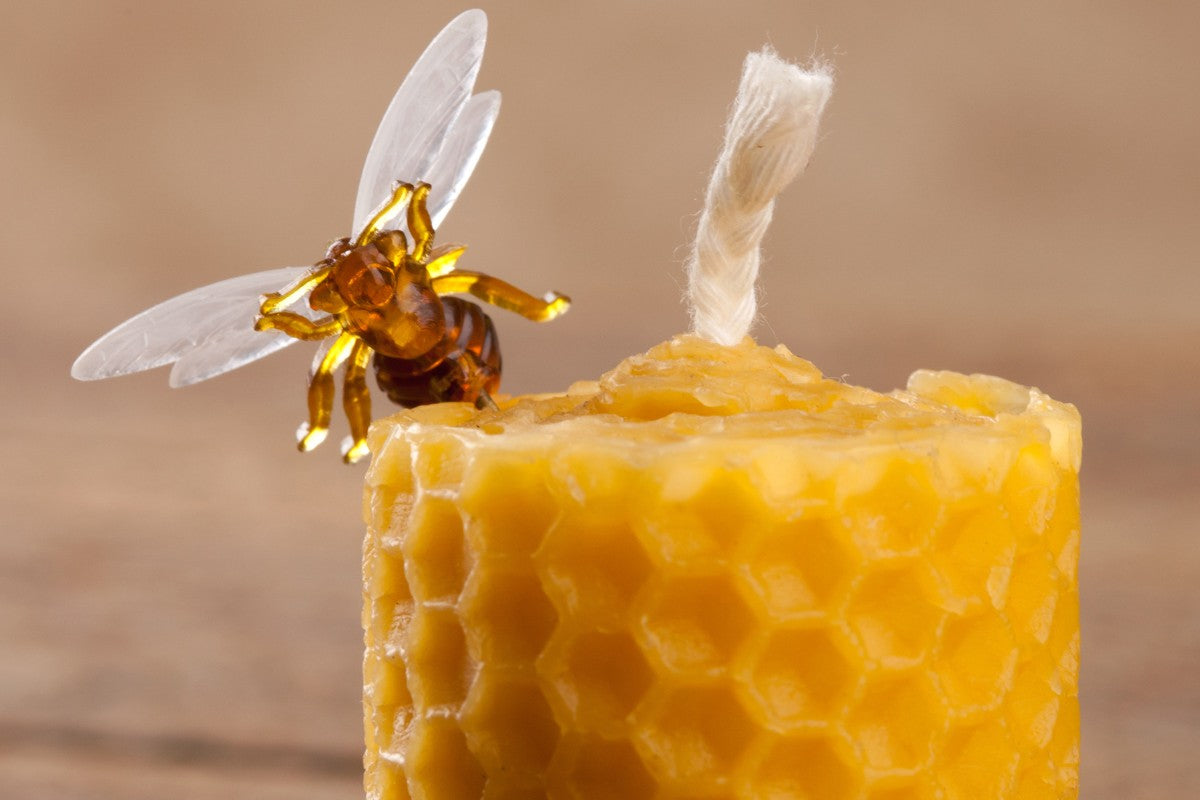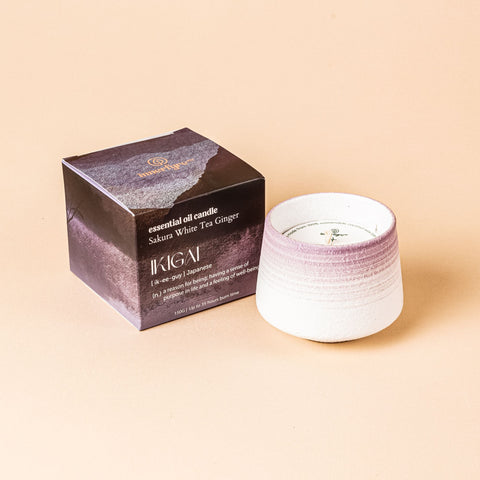
Guide to Beeswax candles: Yay or Nay?
Your choice of wax can play an important part in your health and wellbeing, mentally and physically indeed! While beeswax seems like an obvious choice for its natural properties, beeswax is still, however, a by-product of the beekeeping industry, beeswax candles are certainly not vegan...
How is beeswax produced?

Honeybees have a special gland underneath their belly that secretes a special liquid that starts to become the wax they use for construction.
The bees will scrape off the wax (imagine little honeybees rubbing their little belly) directing it instead to its mouth, subsequently mixing their saliva with the wax by chewing on it to soften the wax for a more pliable building material.
Fun Fact: Bees maintain their hexagonal honeycomb shape for their home to store honey easily as well as tuck away their young.
The process of harvesting beeswax is not complicated.
Firstly, the farmers must suit up to protect themselves and the bees. Following, the farmers will then smoke the hive to rid it of bees and drive them out of harm's way. Smoking (which does not actually harm the bees) causes the bees to believe that the hive is on fire, forcing them to scamper around starting their procedure of evacuation.
Once the bees have left the hive, the wax, as well as the honey, is scrapped off into a container by farmers. What’s collected is then boiled and filtered to remove impurities. After this procedure, the wax is put to cool in cooler water. What remains is pure beeswax!
You can read more about wax and honey harvesting here.
Is it cruelty-free?
Well, you’ll have to look at it this way, most bee farmers clip their queen bee’s wings to ensure that she stays in her ready-made beehive, that’s one thing.
This practice may appear barbaric to some, with good reason. It remains a fact that she (the queen bee) harbors nerves in her wings, although it is not known for certain if she feels pain if her wings were to be cut.
Clipping the queen bee's wings can lead to terrible accidents like a chopped leg or accidentally harming her body.
The main reasons for clipping include; swarming (preventing bees from leaving their nest), which becomes a mark for easy spotting.
Another reason that may sway your decision of ethicality might be that to harvest the beeswax it is necessary to boil the whole hive in water to melt it down. Normally the live bees are smoked out to empty the nest before this procedure starts.
However, there may be remains of larvae if hastily evacuated. So, when it comes to ethicality it’s truly up to you to decide if these measures are okay with you.
Uses of beeswax

Beeswax has a plethora of everyday uses! Some of the main uses of beeswax include:
- beeswax candles (of course!)
- homemade beeswax wraps (a natural alternative to cling wrap)
- polishing for furniture
- lubricating wood
- cosmetics (lip balms, makeup, etc.)
- waterproofing of shoes
- polishing bronze items
- preventing tools from rusting
- unsticking zippers
As well as everyday use, beeswax is a pivotal ingredient in many other products. It can be used in stiffening agents, thickeners, fragrances, lotions, soaps, and emulsifiers.
Benefits of beeswax candles

Did you know: There’s no expiration date for beeswax!
However, it's best to keep it out of direct sunlight and away from heat.
Because beeswax is a natural ingredient it is lower in toxicity when burned, neither does it emit toxic fumes nor much soot. Candles that are made of beeswax have incredible benefits but it is still a natural ingredient, beware sunlight!
Where safety is concerned beeswax candles do not drip much like other candles might.
This may be a relief for families with younger children or even adults who tend to be more clumsy (no shame in that). Beeswax candles also produce negative ions when burning which will neutralize pollutants in the room, eliminating dust, mold in the air, and most odors.
Which is a great plus for those with dust allergies or asthmatic symptoms.
Cons of beeswax

The downside of beeswax is that when exposed to heat it can start to bloom.
Bloom (the whitish film on your candle that starts as a light coat ) does not make a product dangerous or inoperable for use after it appears. For some, bloom can even be a welcome “frosty” or “rustic” effect for their candles.
However, if it concerns you, it’s easy to remove!
You can remove bloom without much effort with some light buffing. With natural ingredients come natural reactions, if your beeswax candle has bloom it just means that your candle is made of 100% beeswax!
On another hand, a graver downside to beeswax is that due to the nature of harvesting, many bees are killed during the process of handling and treatment.
Whether it’s their wings or limbs bees are not 100% safe when it comes to bee farming. Bees will always be at risk if bee farmers continue to touch the hives or relocate them.
Bee farming can aid to increase the population of bees on our planet, which is an incredibly important aspect of our ecosystem! If these methods stated above do not faze you, beeswax is certainly a great product!
However, when comparing beeswax candles to other candle waxes, its scent-throw pales in comparison.
For example, when compared to coconut wax candles, beeswax candles are certainly not as efficient. Beeswax candles have a certain natural sweet-smelling aroma that can also be enhanced or, in contrast, interfere with other ingredients and essential oils...
Better alternatives

If you’re looking for an ethical and vegan alternative to beeswax, coconut wax is definitely the way to go!
Coconut wax’s scent throw is one of the best for candles and scents. It is both obtained naturally and certainly, is 100% cruelty-free! Although both waxes are excellent choices for safe and natural candles, coconut wax is our favorite option.
It also produces a naturally sweet scent but will not overpower or “scent trap” other ingredients mixed into its pour.
Another alternative to beeswax can be rice bran wax, a by-product of rice harvesting.
However, rice bran wax and coconut wax are more expensive to source, which may deter most candle-making companies. Ultimately, making it harder to find on the candle market. Hence beeswax or soy wax are the go-to's for most large-scale candle-making companies.
What about soy wax you may ask?
Soy contains traces of paraffin which can be detrimental to health after long-term use. Most soy candles are not 100% soy either and may be mixed with impure ingredients that may increase paraffin usage (bad). The harvesting of soy can also pose a problem to our environment, soy wax's scent throw is not very strong either.
Learn more about What You Need to Know About Candle Waxes.
Beeswax candles aside
Are you still looking for a great candle that neither harms the Earth or pollutes your room?
At Innerfyre Co we design candles that both use coconut and rice bran wax. Each candle we produce has been fine-tuned to perfectly display and highlight its pure essential oils to lift your mood. Our scents are manufactured for optimal scent throw and lasting quality.
Shop for Scented Candles in Singapore today.


